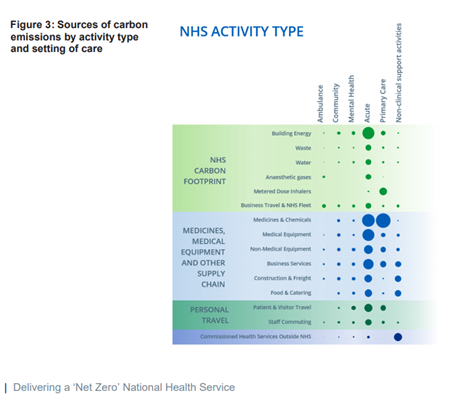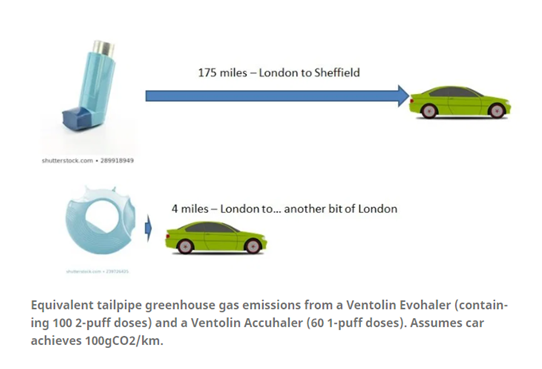Dr Katrina Davies is a GP in Solihull, West Midlands, a member of the GeriGP Committee of the BGS and co-leads the BGS Green Project. She is one of the Royal College of General Practitioners (RCGP) Midlands Faculty representatives on the RCGP Climate Emergency Advisory Panel and recently founded the Birmingham and Solihull branch of the National Greener Practice group. As part of her Masters degree in frailty and integrated care, she will be exploring the barriers and solutions to sustainable healthcare in the context of frailty.
There’s a wave of excitement sweeping through my Zooms. More and more of us in the NHS are hungry for advice about how to reduce our carbon footprint, but many of us just don’t know where to start. I’m a relative newcomer, one of many who have discovered we can each make a difference by taking simple steps. In my field of general practice the tide is turning, thanks to determined groups and individuals who have been working on this for years, such as those who developed the Green Impact for Health toolkit and the Greener Practice movement1234, and have created a rich bounty of resources for all of us to access and adapt in our home and working lives, regardless of specialty. The upcoming BGS sustainability webpage will be featuring these resources and key documents.
Networks of groups interested in “greener practice” are popping up across the country, joining a movement created by the founder of the RCGP Green Impact for Health toolkit, Dr Terry Kemple1 and founder of the Greener Practice website, Dr Aarti Bansal4 . These networks bring together health care professionals from across primary care who want to share ideas and successes, as well as providing mutual support and encouragement; it can be a lonely business trying to make changes! The enthusiasm within these virtual groups is infectious and the stories inspiring, especially when we hear first-hand from patients whose lives have been transformed. The excitement comes from realising that the four main principles of sustainable healthcare share the aspirations of high-quality practice, particularly applicable to the lives of our older population: prevention of ill health, empowering patients and enabling self-management, reducing waste and iatrogenic harm, and using lower carbon alternatives if appropriate5. These principles are embedded in sustainable quality improvement5.
But how do you know where to start in your sector? This figure (also see left) shows the carbon hotspots in the NHS (from page 13 Delivering a Net Zero Health Service 6). As an example, in general practice, the vast majority of the carbon footprint is due to prescribed medicines, with carbon emissions generated in production, transportation and waste. Inhalers are responsible for around 3% of the total NHS carbon footprint
6 , so practices are encouraged to discuss their use with patients in respiratory and medication reviews.A high volume pressurized metered dose inhaler (MDI) unit, such as Ventolin Evohaler™, the most commonly prescribed salbutamol inhaler in the UK7, is responsible for the carbon dioxide equivalent of driving from London to Sheffield (175 miles) due to the harmful hydrofluorocarbon (HFC) propellant gases contained, compared with around 4 miles for a dry powder inhaler (DPI) (see figure right from greeninhaler.org ref 7). Many patients need to continue using MDIs, particularly those needing a spacer device or with poor respiratory effort, so there is an option to change to low volume MDIs, which more than halve the carbon footprint. It was news to me that MDIs leak HFC gases even if just sitting in a cupboard; they continue to do so in landfill sites unless taken back to the chemist for incineration which destroys the gases. There are small-scale pilot recycling schemes underway (for example Teva Inhaler Recycling Service8), but if not available locally, teaching patients when to know the inhaler is empty and encouraging them to return their inhalers to the chemist is an excellent way to reduce their carbon footprint. Undoubtedly the most important factor when considering inhaler alternatives is patient-centred decision-making, prioritising patient preference and ease of use (9), to ensure safe control of symptoms and the avoidance of respiratory admissions, which not only impact adversely on patients’ lives but far exceed the carbon footprint of an MDI inhaler.
So where do we start if we want to know more? The Royal College of GPs has a Green Impact for Health toolkit1 which can be accessed for a test run by anybody using the login gifh@greenimpact.org.uk and password testtoolkit. The site is broken down into 13 areas such as prescribing, social prescribing, quality improvement and vulnerable groups. Within each there are graded levels of actions contributing towards bronze, silver, gold and carbon awards. Social prescribing is becoming a fundamental part of general practice10. Green (in nature) or blue (water based) social prescribing encourages patients to take part in activities outdoors which are low in carbon, low in cost and potentially reduce use of medication, in addition to many well-documented physical, psychological and social benefits11.
A wonderfully uplifting example comes from the video testimony of a patient from Frome Medical Practice near Bristol12. In her late 50s, she had hypertension, peripheral neuropathy, osteoarthritis and walked with a stick. Having been helped initially with strength and balance exercises, dance and yoga, aged 68 she agreed to join a couch to 5k running group which started from the surgery. She was reassured due to the presence of the GP in the group. Over time, her weight and blood pressure improved so she stopped her BP and pain medications, including tramadol and gabapentin; the neuropathic pain was better whilst exercising and her well-being improved. She is now approaching 70 and runs 15 kms a week. The GP got fitter, the patient’s family got fitter and other patients became run leaders themselves to continue the cycle.
These are exciting times. We have the power to improve patient care whilst improving the health of our planet, so that in future our young people will enjoy a “dose of nature” with their own families. If more of us do what we can imperfectly, rather than a few doing it perfectly, we will look back and know we did our best to help the NHS achieve net zero carbon by 2040. Let’s see where we can start today.
2. Centre for Sustainable Healthcare. https://sustainablehealthcare.org.uk/. [Online]
3. Greener NHS. https://www.england.nhs.uk/greenernhs. [Online]
4. Greener Practice. https://www.greenerpractice.co.uk/. [Online]
5. Centre for Sustainable Healthcare. https://sustainablehealthcare.org.uk/susqi. [Online]
6. National Health Service. Delivering a "net zero" National Health Service. s.l. : NHS, 2020.
7. Wilkinson, A. https://greeninhaler.org/. [Online]
8. Teva. https://tevascheme.tevauk.com/dispensing-doctor/support/inhaler-recycling. [Online]
9. for, National Institute for Health and Care Excellence. https://www.nice.org.uk/guidance/ng80/resources/inhalers-for-asthma-patient-decision-aid-pdf-6727144573. [Online] 2020.
10. Royal College of General Practitioners. https://www.rcgp.org.uk/clinical-and-research/resources/toolkits/person-centred-care-toolkit.aspx. [Online]
11. NHS England. https://www.england.nhs.uk/personalisedcare/social-prescribing/green-social-prescribing/. [Online]
12. Hall, Dr Rebecca. https://www.youtube.com/watch?v=wJjtYmS0Q8Q. [Online]



